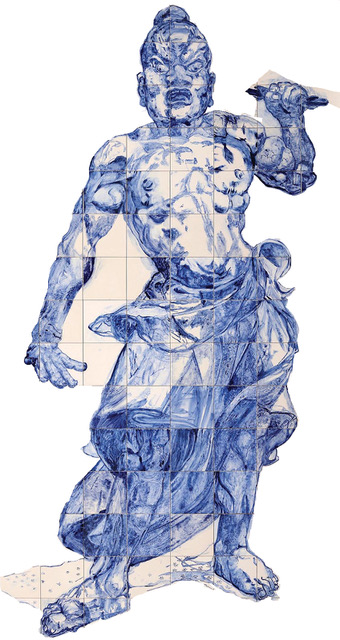Part of this large, broad involvement is the renewed interest in the Iwayaji temple and the cultural heritage in this province that was certainly less in the spotlight in the second half of the 20th century. During the (re)discovery of this part of Japan, that harbours many hidden cultural treasures, and has old relations with the Netherlands, shows a completely different image of Japan, than for instance everyday Tokyo/ Osaka.
Shimane's glorious past is made clear by a good number of special features such as :
Izumo Taisha, (出雲大社, "Izumo Grand Shrine"), is one of the oldest and most important Shinto shrines in Japan. It is the place where //to = according to //lore //the 1000 most important gods //meet// every year (Kamuhakari).
Tatara Steel in Yokota was the main supplier of the Tamagane steel used to make the vast majority of Japanese swords. The Yokota area was - and still is - the location where ferrous sand is mined and washed before being fired. Once a year, at the end of January / beginning of February, the furnace is fired.
The Iwami Ginzan silver mine was the most important silver mine in the world around 1600, accounting for over 30% of world production. Since 2007, the mine has been on the Unesco World Heritage List, with a connotation to the Netherlands as well, as some of the silver was traded through Dejima.
In Shimane Prefecture other connections with the Netherlands can be found, such as in the Tsuwano museum, which not only has a collection of Dutch books, but where great attention is also paid to the philosopher and parliamentarian Amane Nishi who travelled to Leiden in 1863 with the Dutch doctor Dr. J. L. C. Pompe van Meerdervoort to study // political economy and diplomacy with Prof. Simon Vissering, partly due to the intercession of the first professor of Japanese, J.J. Hoffmann/. The time Nishi spent in Leiden has been of great influence on the introduction of western philosophy in Japan and the state-building of Japan according to the European model.
Shimane's glorious past is made clear by a good number of special features such as :
Izumo Taisha, (出雲大社, "Izumo Grand Shrine"), is one of the oldest and most important Shinto shrines in Japan. It is the place where //to = according to //lore //the 1000 most important gods //meet// every year (Kamuhakari).
Tatara Steel in Yokota was the main supplier of the Tamagane steel used to make the vast majority of Japanese swords. The Yokota area was - and still is - the location where ferrous sand is mined and washed before being fired. Once a year, at the end of January / beginning of February, the furnace is fired.
The Iwami Ginzan silver mine was the most important silver mine in the world around 1600, accounting for over 30% of world production. Since 2007, the mine has been on the Unesco World Heritage List, with a connotation to the Netherlands as well, as some of the silver was traded through Dejima.
In Shimane Prefecture other connections with the Netherlands can be found, such as in the Tsuwano museum, which not only has a collection of Dutch books, but where great attention is also paid to the philosopher and parliamentarian Amane Nishi who travelled to Leiden in 1863 with the Dutch doctor Dr. J. L. C. Pompe van Meerdervoort to study // political economy and diplomacy with Prof. Simon Vissering, partly due to the intercession of the first professor of Japanese, J.J. Hoffmann/. The time Nishi spent in Leiden has been of great influence on the introduction of western philosophy in Japan and the state-building of Japan according to the European model.

